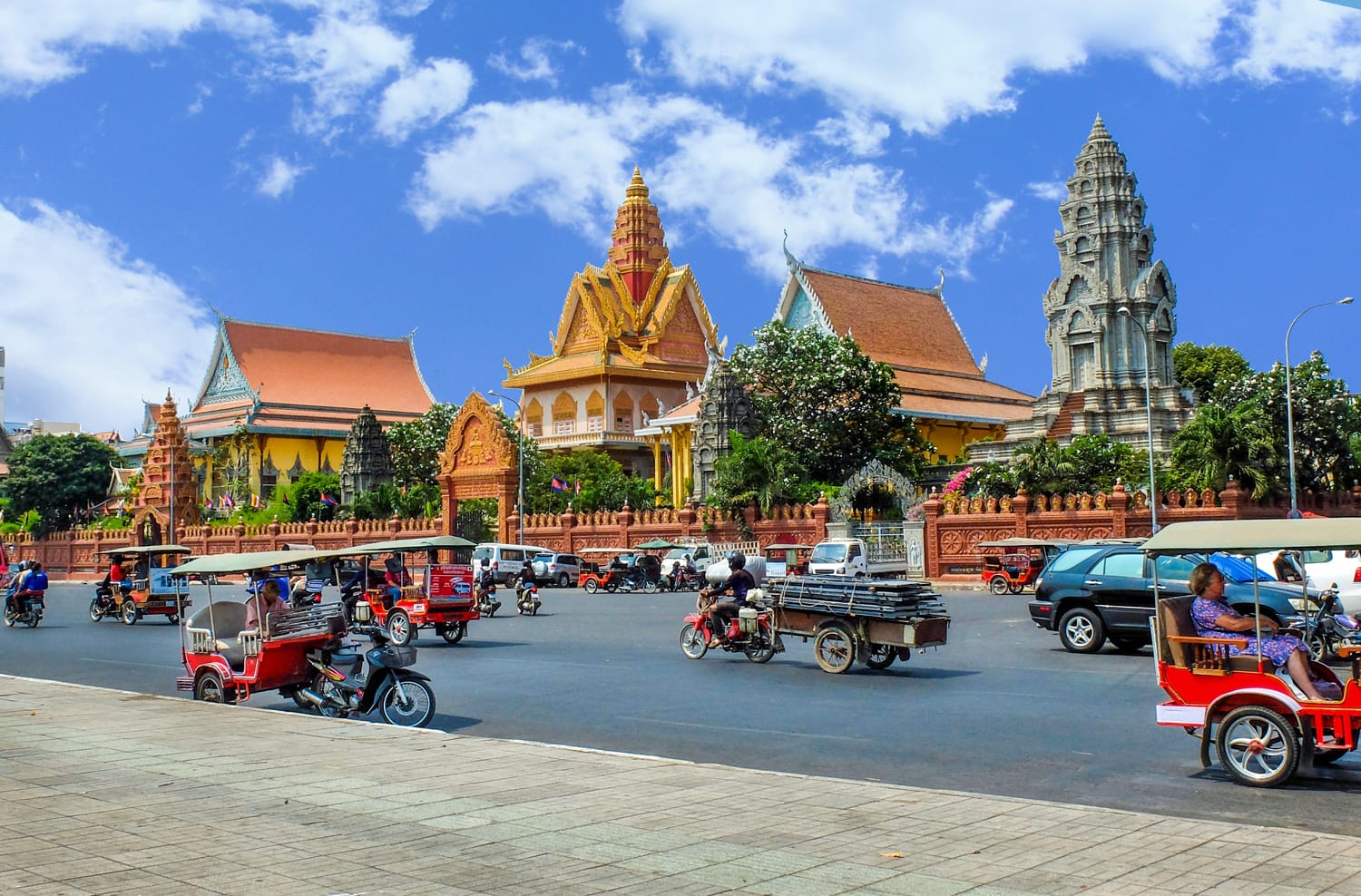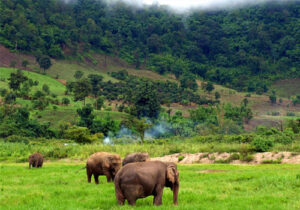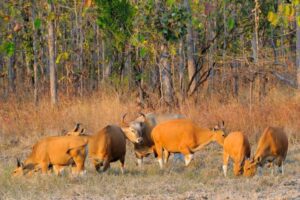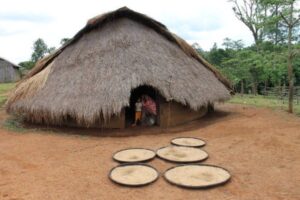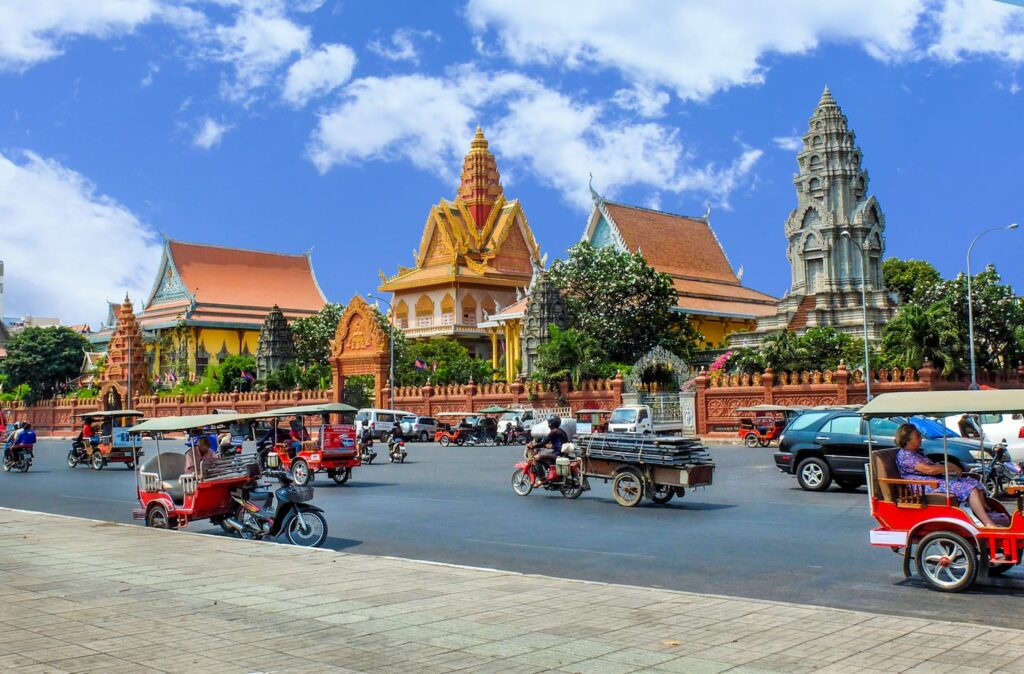
DAY1 : PHNOM PENH TOUR
After your arrival at Phnom Penh international airport, you will be welcomed by our driver or guide and She/He will bring you to your hotel for checking in and then you to visit such as:
- ToulSleng Genocide Museum(S21 Prison)
- Killing Fields of Choeung Ek and Lunch at local restaurant
In the Afternoon
- King Palace & Silver Pagoda and go back to hotel for relaxing
- Russian Market
TuolSleng Museum S 21
Originally built as a secondary school named Tuol Svay Prey High School in 1960, during the reign of Preah Bat Norodom Sihanouk. The Khmer Rouge converted this into a torture and interrogation centre to extract ‘confessions’ of anti-government sentiment. Many victims were women and children incarcerated along with the ‘suspected’ father. Documents recovered indicate that over 17,000 persons had been imprisoned there between 1975 and 1978, only seven of whom are known to have survived.
Choeung Ek of Killing Fields
15km southwest of the city centre is one of the many sites of Khmer Rouge mass executions. The exhumed skulls of some 8,000 souls, arranged by sex and age, are displayed behind glass panels in the Memorial Stupa, which was erected in 1988. Although some were killed and buried at Toul Sleng, most victims were driven out to Choeung Ek at night by truck. Some were made to dig their own graves before being clubbed to death with any heavy instrument available.
Royal Palace & Silver Pagoda
Built in 1866, the site contains various buildings of interest, including the Khmer-style Throne Hall, now used for special ceremonial occasions. South of the Throne Hall are the Royal Treasury and the Villa of Napoleon III, built in Egypt in 1866, for the opening of the Suez Canal , and was later presented to the Cambodian king as a gift.
Russian Market
Russian Market is the most popular market among tourists and expats and probably the best place to pick up souvenirs. It does not look like much from the outside but when you get in you will find everything from beautifully hand carved statues, colorful lanterns and handmade silk scarves to fake bags, printed T-shirts and DVDs.
Russian market is located in the south part of Phnom Penh and is known to the locals as Phsar Toul Tom Poung. The reason why it is called Russian market is because it was a popular market among the Russian expats during the 1980s when most of the western expats in Phnom Penh were Russian.
It is a narrow and sometimes steamy market since most of the stalls do not have Air-conditions or even a fan, but it is still worth the visit and if you get tired you can always take a relaxing coffee at one of the coffee shop around the market.
DAY2:PHNOM PENH CITY TOUR
After breakfast at 8 : 00 am you will be welcomed again by our driver or guide will bring you to visit attraction places such as :
- National Museum
- Wat Ounaloum
- Wat Phnom Historical &Tourism Site and Lunch at any restaurant along the riverside.
In the Afternoon
- Central Market
- Independent Monument
- Boat Trip on Mekong River to see floating village and sunset
National Museum
Located just noth of the Royal palace, the National Museum of Cambodia is housed in a graceful terracotta structure of traditional design ( built 1917 -20 ), with an inviting courtyard garden. The Museum is home to the world’s finest collection of Khmer sculpture- a millennium’s worth and more of masterful Khmer design. The Museum comprises four pavilions, facing the pretty garden. Most visitors start left and continue in a clockwise , chronological direction. The first significant sculpture to greet visitors is a large fragment-including the relatively intact head, shoulders and two arms -of an immense bronze reclining Vishnu statue recovered from the western Mebon temple near Angkor wat in 1936. Continue into the left pavilion, where the pre-Angkorian collection begins. It illustrates the journey from the human form of indian sculpture to the more divine form of khmer sculpture from the 5th to 8th centuries. Highlights include an imposing eight armed Vishnu statue from the 6th or 7th century found at Phnom Da and a starting Harihara , combining the attributes of Shiva and Vishnu. The Angkor collection includes several striking statues of Shiva from the 9th ,10th and 11th centuries ,a giant pair of wrestling monkeys, a beautiful 12th century stele( stone )from Oddar Meanchey inscribed with scenes from the life of Shiva , and the sublime statue of a seated Jayavarman VII( 1181-1219),his head bowed slightly in a meditative pose. The Museum also contains dispays of pottery and bronzes dating from the pre-Angkorian periods of Funan and Chenla 4th to 9th centuries, the Indravarman period ( 9th and 10th centuries ) and the classical Angkorian period 10th to 14th centuries, as well as more recent works such as a beautiful wooden royal barge.
Wat Ounalom
Built in 1443 to enshrine a sacred hair of the Buddha, and located north of the National Museum of Arts, this temple is considered the seat of Cambodian Buddhism. When the Khmer Rouge evacuated Phnom Penh in 1975, they vandalized the building and murdered the Abbot along with many of the 500 monks who lived there.
Wat Phnom
Wat Phnom is a Buddhist temple located in phnom penh , Cambodia. It was built 1372, and stands 27 meters above the ground it is the tallest religious structure in the city. The pagoda was given the name of Wat Preah Chedey Borapout. On the hill there is a large stupa that holds the cremains of king Ponhea Yat and his royal family. Inside the stupa , there is a Buddha statue from Angkorean era , from the 9th – 13th centuries.
Central Market
The Central Market (Khmer: ផ្សារធំថ្មី, “Psah Thom Thmey”, “New Grand Market”), is a large market constructed in 1937 in the shape of a dome with four arms branching out into vast hallways with countless stalls of goods. Initial designed by Jean Desbois (1891 Cherbourg -1971 Lorient). Construction works were supervised by French architect Louis Chauchon (1875 – 1945 Saigon) and the ingenue Wladimir Kandaouroff.
It is located in Cambodia’s capital city, Phnom Penh. When it first opened in 1937, it was said to be the biggest market in Asia; today it still operates as a market. From 2009 to 2011, it underwent a US$4.2 million renovation funded by the French Development Agency.
The unique Art Deco building is a Phnom Penh landmark. Before 1935, the area was a lake that received runoff during the rainy season. The lake was drained and construction began in 1935. Since its completion in 1937, wet season flooding around the market has remained a problem and is vestigial evidence of the old lake. The entrance to the market is lined with souvenir merchants hawking everything from T-shirts and postcards to silver curios and kramas. Inside is a dazzling display of jewels and gold. Electronic goods, stationery, secondhand clothes and flowers are also sold. During the Franco-Thai war the market was bombed heavily by Thai aircraft, causing heavy damage, and it had to be temporarily closed. After the end of World War II the market was rebuilt in the modern style.
Independence Monument
The Independence Monument (Khmer: វិមានឯករាជ្យ, “Vimean Ekareach”) in Phnom Penh, capital of Cambodia, was built in 1958 to memorialize Cambodia’s independence from France in 1953. It stands on the intersection of Norodom Boulevard and Sihanouk Boulevard in the centre of the city. It is in the form of a lotus-shaped stupa, of the style seen at the Khmer temple at Banteay Srei and other Khmer historical sites.[1] The Independence Monument was designed by the Cambodian architect Vann Molyvann.
During national celebrations, The Independence Monument is the center of activity. A ceremonial flame on the interior pedestal is often lit by a royal or high official on these occasions, and floral tributes line the stairs. Every year, The Independence Monument is visited by foreigners and locals alike. Behind the monument is the Norodom Sihanouk Memorial, constructed in 2013.
Boat Trip on Mekong River
Cruising along the Phnom Penh riverfront, enjoy the view from the upper deck or down on the main deck for a more cozy experience near the bar. Passing the Royal Palace, see the junction of the Tonle Sap, Mekong, and Bassac Rivers. Up the Mekong River you will see floating villages and fishing families living on their boats. The trip to Silk Island takes about 1 hour. Docking at Silk Island you are a short ride away from the silk farms. Along the way you can view plantations and see village life. A traditional pagoda nearby is also an active monastery. This is not a tourist attraction, be respectful. At the silk farms you can watch the intricate process of silk being made from larvae to finished goods.
Tour guides will be provided. The boat will be open for food, drinks, relaxing or for using the facilities while in port. On the 1-hour ride back to Phnom Penh cool off with a cocktail. Snacks will be provided, if the lunch option was purchased. The cruise boat is a newly constructed vessel designed solely with lunch/dinner cruising in mind. With 365 degree views from the top, it has 140 seats with a rustic, wooden, Cambodian design with modern touches. It is equipped three toilets, men’s, women’s, and staff’s, running water from fresh water tanks, and a water filtration system for clean, purified drinking water. Hygiene, safety, and guest satisfaction are the priorities. A large commercial kitchen with floor to ceiling stainless steel walls and appliances, and rubber flooring is designed to prepare food for up to 120 guests in short order. The boat is licensed, inspected, and has staff that is well-trained in safety and first-aid procedures, with flotation devices, safety equipment, and fire extinguishers onboard. No other boat in Phnom Penh can offer you all of these things.
DAY3: OUTSIDE OF PHNOM PENH CITY TOUR
Today is the last day of your 3 day tour, and you will visit:
- Prasat Phnom Chiso
- Neang Khmao Temple
- Taprom Temples and Tonle Bati
Back to your Hotel or drop off at Phnom Penh International Airport End of Tour
Chisor Mountain
A temple from the Angkorian era, Phnom Chisor is set upon a solitary hill in Takeo Province, offering panoramic views of the countryside. Try to get Phnom Chisor early in the morning or late in the afternoon, as it is an uncomfortable climb in the heat of the mid-day sun. Phnom Chisor lies about 52 km from Phnom Penh.
The main temple stands on the eastern side of the hilltop. Constructed of laterite and brick with carved lintels of sandstone, the complex is surrounded by the partially ruined walls of the 2.5m-wide gallery with windows.
inscriptions found here date from the 11th century, when this site was known as Suryagiri. The wooden doors to the sanctuary in the center of the complex, which open to the east, are decorated with carvings of figures standing on pigs. Inside the sanctuary are statues of Buddha.
On the plain to the east of Phnom Chisor are the sanctuaries of Sen Thmol, just below Phnom Chisor, Sen Ravang and the former sacred pond of Tonle Om. All three of these features form a straight line from Phnom Chisor in the direction of Angkor. During rituals held here 900 years ago, the king his Prahmans and his entourage would climb a monumental 412 steps to Suryagiri from this direction.
There is a spectacular view of the temple and plains from the roofless gallery opposite the wooden doors to the central shrine. Near the main temple is a wooden buddhist vihara that is used by resident monks.
Neang Khmao Temple
These two temples were made of stones and bricks, in the size of 4 square meters and 10 meters high with the narrow top of its lofty tower. The tale related to this temple is as the following:
A long time ago, there was a king named King Sorya Tevong, stayed in Chiso Mountain. The king built five temples with four ponds dug at all directions of the temples. King Sorya Tevong had a daughter named Neang Khmao. The distance from the top to the foot of the mountain was 700 meters and there were four rivers at the four directions: TonIe Om, TonIe Snguot, TonIe Sdok and TonIe Protron, where King Sorya Tevong always visited. When his daughter grew up at the age of 16 years, she was the most beautiful girl in the kingdom.
One day, the princess wished to enjoy at Tonle Proton, she went to salute her father for the permission. The king permitted and ordered the royal servants to accompany her in the afternoon. Meanwhile, there was a man named Pundit Srey who had just resigned from the monkhood. He was a very handsome man with knowledge of magic. He resided in a village in the west of Chiso Mountain near a route to Tonle Proton. With his boredom, Pundit Srey went for a walk near the route. He saw the princess with her companions coming down the mountain and instantly fell in love with the prince at the first sight.
Pundit Srey thought: “Today I am very lucky to see a perfect lady. But I’m only a son of the poor family; how can I marry her. She doesn’t match me, since she’s not an ordinary citizen, but she is the princess of King Sorya Tevong. What shall I do?” The more Pundit thought, the more he loved the princess. He thought to himself, “If I ask her to marry me according to the law and tradition, surely, it’ll be not appropriate. It’ll be my misbehavior, thus the king must punish me to death.”
His love for her was growing too much, so Srey Pundit decided, “although the king punishes me, I would rather die for her.” By thinking so, Pundit recalled the magic skills he had studied. He picked up a leaf, and rolled it. He recited the magic and blew it to make beautiful sound and then he climbed up a tree to blow it in order to make the sound louder. This charming sound attracted the heart of Princess Neang Khmao. She became confounded for a while, and then she woke up and thought, “I’m a daughter of the king. I always listen to music every day, but no sound of music has made me very shocked as this does.” She could not help her temptation and lost her tongue, “Gee, what a sound! I must seek and see who’s blowing so beautifully.” Then she went to look for the sound alone.
When she saw the beauty of Pundit Srey, the prince loved him stronger. They chatted in the way that a maiden and a young fellow loved each other. They both promised to meet again and then were separated. After meeting Pundit Srey, the princess seemed so sad and unhappy as well as very quiet. Someday later, she went to her father for permission. Again, the king permitted and offered the companions to accompany her. Where she arrived at the place where she promised with the young fellow, she told her servants, “Wait for me here. I’ll go over there for a bit affair.” Then, the princess walked toward Pundit Srey. They both were very happy and excited to meet again as expected. Her servants were very curious; they went to peep at her. The misbehavior of the princess made them afraid that the king might punish them to death. They decided, “We must inform the king.”
After they arrived at the royal palace, the servants told the king what they had seen. The king was very furious. He called in the executioners and said, “Take my daughter to put to death.” But the Queen implored, “Your majesty, please forgive her. If it is her fault, please don’t put her to death; just exile her from the palace.” The king agreed on his wife’s request. He ordered the chief of an army to construct two temples 3 Yojanas (Yojana is an ancient unit of measurement equivalent to about 16 kilometers) from the royal palace.
The royal officials built the temples as the king’s order. Then the king ordered his daughter, Preah Neang Khmao, to live there in the temples, situated in the west of Chi so Mountain. Since then, the princess was depressed for being exiled alone By her father and separated from her sweetheart who she had not seen and heard nothing. At that time, there was a monk named Phikkhu Keo wo had left his home to study magic. The monk had highly educated and later he returned to his hometown and stayed in a village (in Takeo) where the water was very scarce, so the villagers dug a pond for him. Since the pond belonged to Phikkhu Keo, it has been named Sras Keo up to now. When he stayed there longer and his reputation was spread out to all villages.
Keo.When she arrived at Phikkhu Keo’s place, she came in to respect the monk as the tradition. After she had seen the monk clearly, she was attracted by his beauty handsome, lovely and greater than Bandit Srey, the princess no longer remembered him and felt in love with Phikkhu Keo. After she told the monk everything about herself, they both seem to have close relationship with each other as if they had met before. The description of her sorrow made the monk so sympathetic towards the princess and talked to her in a consolatory manner. After the princess had heard the pleasant words from the monk, she hoped, “I won’t be sad any longer”.
Since then, the princess had fresh complexion and was as beautiful as a nymph. While Phikkhu Keo tried to do meditation to forget her, but he could not. Sometime later, the princess went to ask for the monk again to pour holy water on her body for happiness. That time she showed much closer relationship to Phikkhu Keo and said, “Please make peace and quiet in your mind.” When hearing her words, his face was getting upset. This behavior showed the princess that the monk was sad because of her, too. Thus the princess felt deeper love for him.
After she came back to her temple, the princess could not eat and sleep well. She ordered her servants to prepare an elephant to invite the monk to her temple. While seeing the servant come to invite him, Phikkhu Keo was very happy and hurriedly got dressed to depart. The princess prepared a variety of exotic food for him. When he arrived, the princess offered the food to the monk by herself. Phikkhu Keo saw lots of food, but unable to eat, the princess was getting very sad. And despite a loss of her reputation, she said to the monk, “Please resign from the monkhood.”
The princess offered plain clothes and jewelries and Phikkhu Keo agreed on her request. He resigned from the monkhood, becoming a layman, and shared happiness and pain with Preah Neang Khmao in the temple forever. According this legend, the temples have been named Prasat Neang Khmao ever since. Long later, the Buddhist believers were happy to build a pagoda there, and so the pagoda has been called Wat Prasat Neang Khmao up to now.
Taprom Temple and Tonle Bati
Taprohm Temple adapted from Bayon style, was built during the late 12th and early 13th centuries, during the reign of King Jayavarman VII ( AD 1181-1220 ) as a place of worship for Brahmans and Buddhists. The temple is 42 meters long, 36 meters wide and 11 meters high. Today the temple body, the gallery , the wall, gopura and the moat surrounding the temple are heavily damaged. The temple was constructed of brick and laterite and divided into many rooms. The outside wall is decorated with bas-reliefs illustrating the Brahman story about the celestial nymph. Inside the temple are five rooms and a 13th century Buddha statue that faces East.
Tonle Bati Is located in Thnal Teaksin village, krang Thnoung commune, Bati district, about 35 kilometers from Phnom Penh. Tonle Bati is a place of worship and features two ancient temples , Taprohm and Yeay Pov , and a pagoda, Wat Tonle Bati, which was built in 1576.
Yeay Pov Temple
Yeay Pov temple is behind Wat Tonle Bati , about 100 meters from Taprohm temple. Constructed of sandstone in the 12th centuries, it is 7 meters square and faces East. In addition, there is also a natural lake that is 7000 meters long. During the dry season the lake is 1000 meters wide and 1 to 2.5 meters deep. During the rainy season it swells to 1,500 meters wide and is about 4 meters deep.


